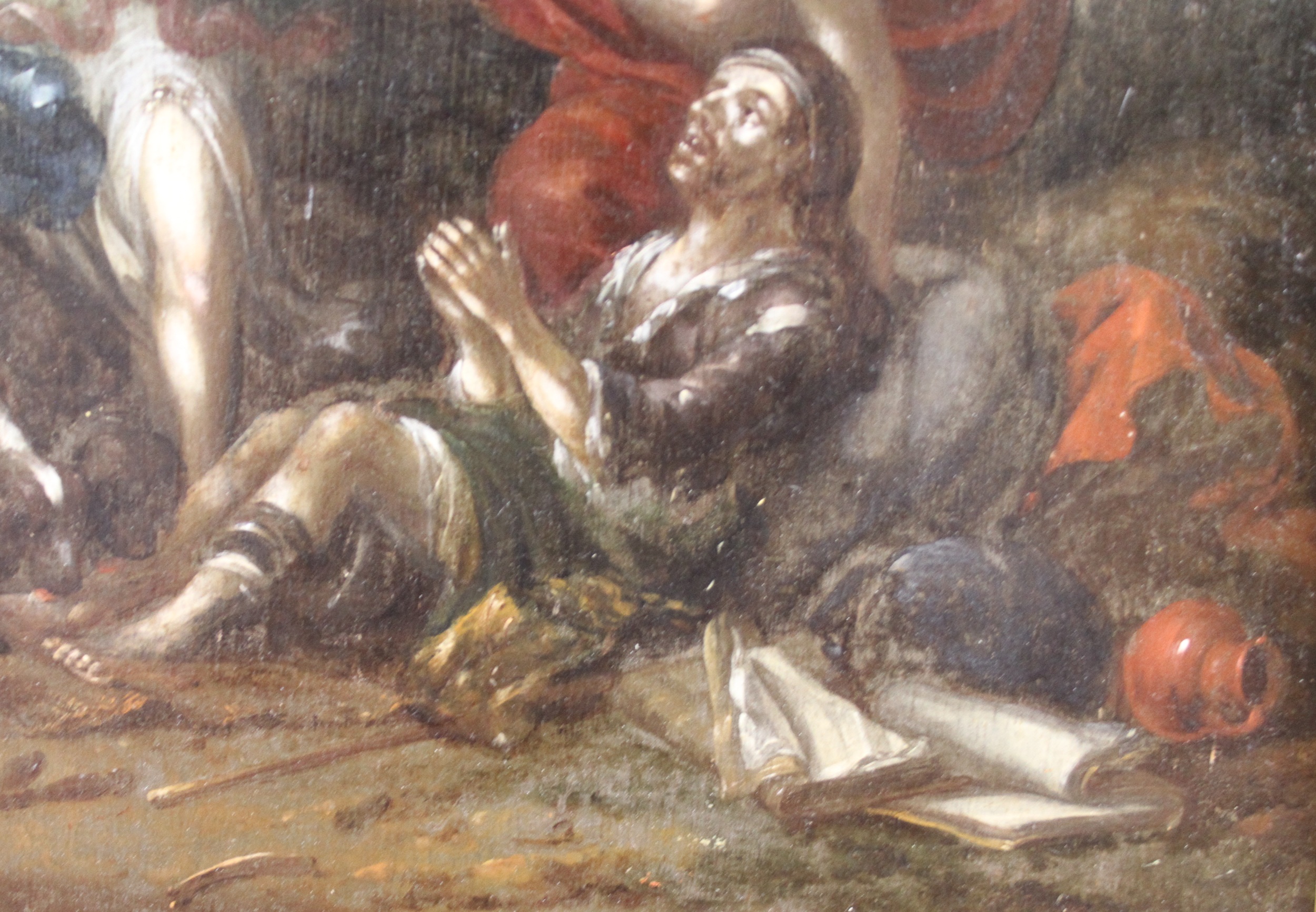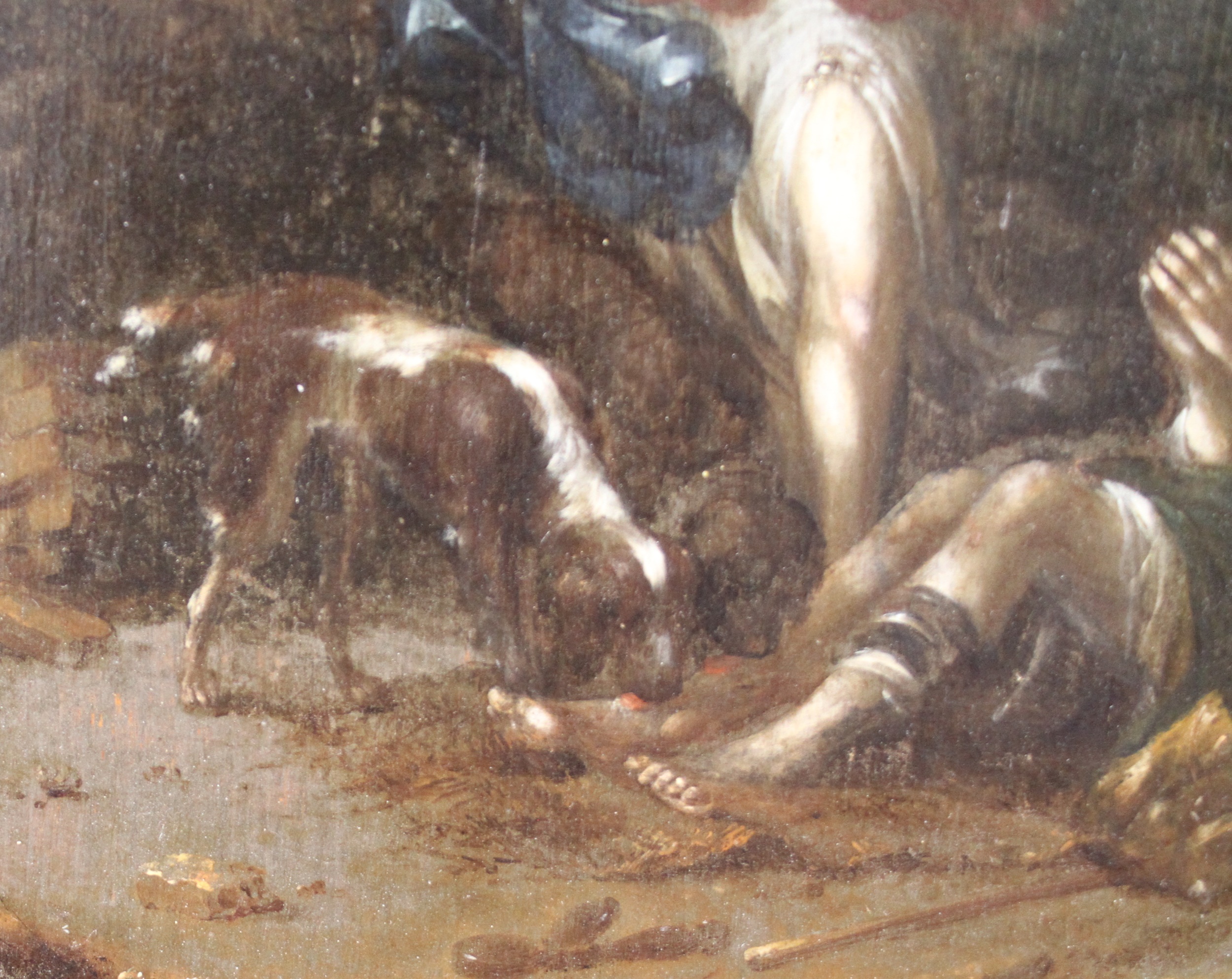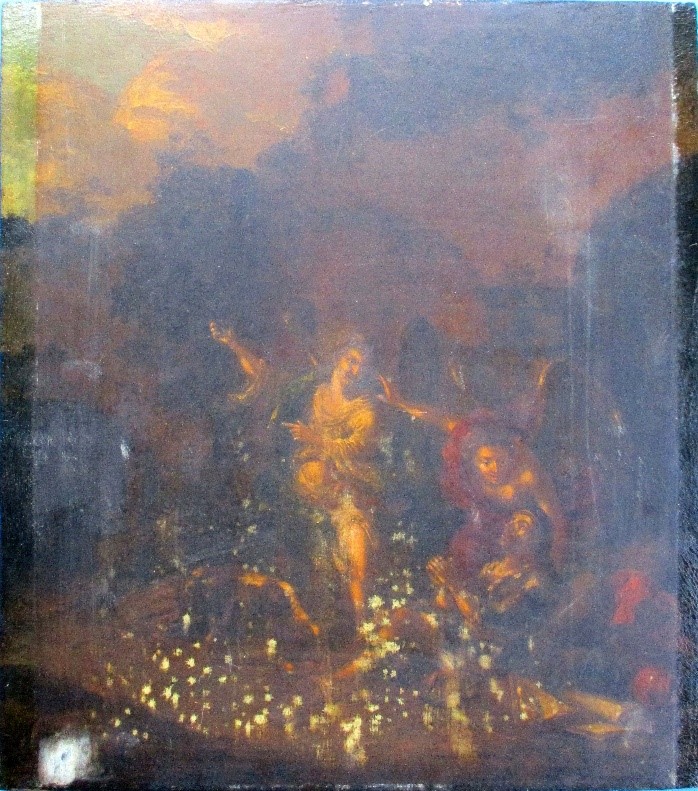Vendor's research into lot 2384 in our 16th September 2023 Fine Art & Antiques auction
.JPG)
Lazarus and the Angels.
Flemish/Dutch School, ca: 1675.
Oil on oak panel
18 ¾” x 16 ¼” (475 x 415mm).
Introduction:
Believed to be a preparatory sketch or study, the present work, discovered last year in South Africa and fresh to the market, depicts the seated figure of the beggar Lazarus, hands clasped in prayer, as he is visited by two consoling angels in preparation for his ascent into heaven.
In the foreground, a pair of dogs can be seen attending to the sores on his legs; there is biblical reference to this in Luke:16.21. It was a long held belief that canine saliva held mystical, cleansing and curative power, even today it is recognised to have some antiseptic value. The dog’s simple act of benevolence therefore, coupled with the sublime presence of angels comforting the wretched beggar in his final hours, at once embodies the painting with a deeply spiritual significance that simply cannot be ignored. And thus, with a lifetime of earthly torment about to end, his escort has finally arrived and an everlasting peace now awaits poor Lazarus in Heaven.
 Bottom right one can see an overturned urn or pitcher, a symbol of spiritual anointment alongside large open books, symbolic perhaps of the divine authority of the scriptures and the power of knowledge and learning.
Bottom right one can see an overturned urn or pitcher, a symbol of spiritual anointment alongside large open books, symbolic perhaps of the divine authority of the scriptures and the power of knowledge and learning.
The iconographic interpretation of these items may vary of course with the passing of time. So the specific meaning of these deliberately placed items in the painting’s composition must be seen in the context of the period in which it was painted, as well as the possible values that the artist, and/or commissioning benefactor, wished to convey at the time.
It is important to remember that the raising of Lazarus (brother of Mary of Bethany) and the Parable of Lazarus and the Rich Man are two separate things, and involve two entirely separate individuals, this is an image to do with the latter, sometimes referred to as the parable of Lazarus and Dives, as recorded in the New Testament Gospel According To Luke.
There are numerous artistic depictions of the beggar Lazarus, however most of these show a prostrate Lazarus feeding on the scraps from the rich man’s table.
 Interestingly, many people misinterpret the dog’s presence, thinking they are simply scavenging mongrels, however in truth their biblical significance is one of companionship, charity, and pity:
Interestingly, many people misinterpret the dog’s presence, thinking they are simply scavenging mongrels, however in truth their biblical significance is one of companionship, charity, and pity:
Luke 16:19-22.
19 Jesus said, “There was a certain rich man who was splendidly clothed in purple and fine linen and who lived each day in luxury.
20 At his gate lay a poor man named Lazarus who was covered with sores.
21 As Lazarus lay there longing for scraps from the rich man’s table, the dogs would come and lick his open sores.
22 “Finally, the poor man died and was carried by the angels to sit beside Abraham at the heavenly banquet….
The present work is most unusual in that it clearly illustrates both Lazarus and the Angels, as well as the attendant dogs that nurse him. The rich man, who is not named in the Gospel, has no part to play in this episode. The actual ascent of Lazarus with the angels, and indeed his subsequent arrival in Heaven alongside Abraham, is a biblical theme that has been revisited by artists over the centuries, however the present work, collectively illustrating as it does the living Lazarus, dogs and visiting angels, appears somewhat unique.
Research:
Exploratory online research in respect of attributable artist, or a larger painting containing recognisable elements of the present work, has thus far drawn a blank. Given the subject matter, the era and subsequent passage of time, this is perhaps not so surprising.
Although the political and religious turmoil of the Eighty Years’ War (1568–1648) profoundly affected 17th-century Dutch society, there nevertheless remained a steady output of biblical paintings, especially in the decades following the end of this turbulent period. Unlike the grand public altarpieces made for Catholic churches by Flemish artists, most Dutch religious paintings, like Rembrandt’s emotionally evocative renditions of New and Old Testament stories for example, were meant for private display and contemplation. Hidden away from view therefore, and thus immune from historical record and scholarship over time, countless hundreds of centuries-old religious works of art remain undocumented even to this day.
Did the present work ever actually spawn anything much grander, or should it be seen simply as a stand alone reminder of a Golden Age? If, as it has been suggested, the present work is in fact a preparatory sketch or study, there is presently no evidence to suggest that a subsequent commission was ever forthcoming. And if there was, its whereabouts remain a mystery. Nevertheless there is no doubting the fact that the present work, humble as it may be, not only took on a life and a journey all of its own, but survived.
Background:
Quite how the painting actually arrived in South Africa in the first place may never be known. It was found on a farmstead in Kwa Zulu Natal, in an old trunk wrapped up in a horse blanket together with a rather musty old saddle and some other items of equine paraphernalia. Might these have been the chattels of a migrant Victorian or Edwardian family; or a much earlier generation, possibly more contemporaneous with the painting itself? If so, perhaps historical precedent may provide some clues: By the middle of the 17th century, Dutch merchant vessels had established a repair and provisioning hub in Cape Town as they made their way further afield to trade in Asia and the Far East. The Dutch East India Company was born out of these pioneering endeavours and effectively, under the governance of Jan van Riebeck in 1652, set about the colonisation of vast swathes of Southern Africa.
Back in Europe, specifically the Netherlands and Flanders, word quickly spread of the discovery of this ‘New World’ and the opportunities and indeed riches that might await those who wished to settle there. Farming and construction skills were needed, as well as metal-working, textile and garment manufacture, food production, wine making etc and so artisans from across these, and many other trades and professions, bade farewell to their homeland and headed for the docks, eager to find passage and try their luck far away in this strange land of seemingly endless bounty. They were called The Voortrekkers and the derivative version of the tongue they took with them, Afrikaans, is widely spoken to this day.
By the middle of the 18th century, multi-generational families had left the ‘low countries’ in their hundreds; young children together with their grandparents, sandwiched aside a generational corps of hard-working, tough and resilient men and women in their prime… With them they took what they could safely carry; clothes, cooking utensils, essential tools – every family had with them a Bible and with it a strong and passionately held Christian faith, a fear of God and unshakeable belief in the scriptures – it was perhaps the only book they possessed. With that, often wrapped in protective muslin, a devotional item would be found; a crucifix, a carving of the Madonna and Child, or a small painting – something inspirational, a talisman and reminder of the power of their faith, a constant source of narrative from which endless stories might be spun on those long lonely nights aboard ship or huddled together under canvas in the country that awaited them.
It is thus easy to imagine the power of the present work in the hands of a skilled storyteller, weaving spells around the flicker of candlelight:
-
The parable of the rich man, and of the poor man.
-
The reversal of fortunes, the absolute futility of vast wealth at the moment of death.
-
The future that would ultimately befall all those who failed to heed the word of the Lord, those who lived a cruel and selfish life, one without charity.
-
The horrifying, terrible fate of damnation without mercy; in hell at the hands of Satan.
-
The blind foolishness of those who believed their riches could always buy themselves out of trouble, anything – including eternal life in heaven.
-
And of course how a sick, destitute and homeless man could find salvation simply by his faith in the Grace of God...
It remains the stuff of endless Church sermons, safely delivered from the cloistered environment of the local parish pulpit. Yet three hundred or so years ago, on an untamed landscape with not a steeple in sight, a small community had to make do and find their own place of worship – and a bible, a candle and a devotional work of art would always be at its heart.
Whatever journey this painting has taken since it was conceived, the parable at its core, especially the moral imperative it conveys, still provides the bedrock of belief for countless millions across the globe.
Conservation:
The painting was discovered in a relatively poor condition with thick yellowing varnish ‘blooming’ in the lower third of the work obscuring much of the detail below. The oak panel, upon which it was painted, was remarkably flat and in good order. Academic experts in Cambridge were of the opinion that this was purely superficial, and that with appropriate care and skilful restorative conservation it could be successfully removed. This proved to be entirely correct once in the highly experienced hands of Rebecca Leathley in London. Renowned for her lightness of touch, many decades of grime and discoloured varnish have been painstakingly removed. The surface is now clean, and the detail has come alive.
Dendrochronology:
The substrate oak panel has been forensically examined by the renowned dendrochronologist, Dr Ian Tyers. He subsequently deduced that the last growth ring of the tree from which this panel was harvested was 1663, giving a Terminus Post Quem for the painting itself of 1671. Accordingly the work cannot have been made prior to this date and was most likely painted within a ten year time frame and thus can be dated, with some confidence, to ca: 1675.
The following is an extract from his detailed report>
Tree-ring analysis of a panel painting: Lazarus and the Angels
Dendrochronological Consultancy Report 1433.
Summary:
This panel contained a single oak board. Analysis of the tree-ring sequence identified this timber was sourced from Belgium, north-eastern France or southern Germany, with a latest heartwood ring of 1663. Allowing for the minimum likely amount of missing sapwood this panel probably dates from after c. 1671.
Lazarus and the Angels
DCL object reference OS1686
This panel was c. 414-413mm wide and c. 476mm high. It comprised a single tangential oak board. The board was aligned vertically with the outermost rings towards the right edge of the panel. Sapwood was not present along the right edge of the board.
Ring width series were recorded from the upper and lower edges of the board, these were synchronised to produce a single composite sequence (Table 1). The innermost rings could not be recorded as the cross-section became increasingly tangential as it approached the centreline of the tree, which was located near the left edge of the panel. The sequence was found to match against Belgian, north-eastern French and southern German reference data.
The result indicated that the tree used for this panel was still growing in the year of the latest ring present in the panel, at 1663. The expected number of sapwood rings for Belgian, north-eastern French and southern German sourced material is 8 years as a minimum. The minimum figure can be added to the latest heartwood ring to provide a terminus post quem date for the panel, this board was therefore derived from a tree that was felled after 1671. This interpretation is shown on Figure 2, and in Table 1. Timber from this region was widely used in board form in the later 17th and early 18th centuries in both England and the Low Countries, it was probably floated down the Meuse from forests along the valley.
Dendrochronological analysis dates the boards of a panel and does not date the painting. The Lazarus and the Angels painting cannot be earlier than the date of this board, and it was most likely contemporary with the panel. However it could have been painted later, re-using an earlier panel, though this practise was relatively uncommon. Other technical analyses would be required to determine if the present image includes later repainting, or evidence for an earlier use.
References:
Baillie, M G L & Pilcher, J R, 1973 A simple crossdating program for tree-ring research, Tree Ring Bulletin, 33, 7-14
English Heritage, 1998 Dendrochronology: guidelines on producing and interpreting dendrochronological dates, English Heritage
Schweingruber, F H, 1988 Tree Rings, Kluwer Academic Publishers
Tyers, I, 2005 Tree-ring analysis of a panel painting: A portrait of Mary Kytson, ARCUS Rep,922m
Tyers, I, 2006 Tree-ring analysis of two panel paintings: Portraits of Sir George and Mary Fermor, ARCUS Rep, 922n
Tyers, I, 2008 The tree-ring analysis of a piece of furniture: Temple Newsam House, Still Room, China Presses, Dendro Co Rep, 216
Tyers, I, 2013 The tree-ring analysis of an item of furniture: The Mary II Coronation Chair, Dendro Co Rep, 608
Tyers, I, 2016 The tree-ring analysis of a panel painting: Studies of Fruit, artichokes & a sprig of oak, Dendro Co Rep, 849

Lazarus and the Angels
OS1686 Single board Calendar Years
Span of ring sequences
AD1550 AD1650
after 1671
 Bottom right one can see an overturned urn or pitcher, a symbol of spiritual anointment alongside large open books, symbolic perhaps of the divine authority of the scriptures and the power of knowledge and learning.
Bottom right one can see an overturned urn or pitcher, a symbol of spiritual anointment alongside large open books, symbolic perhaps of the divine authority of the scriptures and the power of knowledge and learning. Interestingly, many people misinterpret the dog’s presence, thinking they are simply scavenging mongrels, however in truth their biblical significance is one of companionship, charity, and pity:
Interestingly, many people misinterpret the dog’s presence, thinking they are simply scavenging mongrels, however in truth their biblical significance is one of companionship, charity, and pity: